| Listing 1 - 10 of 11 | << page >> |
Sort by
|
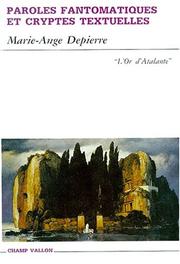
ISBN: 287673172X Year: 1993 Publisher: Seyssel Champ Vallon
Abstract | Keywords | Export | Availability | Bookmark
 Loading...
Loading...Choose an application
- Reference Manager
- EndNote
- RefWorks (Direct export to RefWorks)
Comparative literature --- Thematology --- Criticism, Textual --- Ghosts in literature --- Critique textuelle --- Fantômes dans la littérature --- Fantômes dans la littérature
Book
ISBN: 9782862726205 2862726206 Year: 2012 Volume: 161 Publisher: Saint-Etienne : Publications de l'Université de Saint-Etienne,
Abstract | Keywords | Export | Availability | Bookmark
 Loading...
Loading...Choose an application
- Reference Manager
- EndNote
- RefWorks (Direct export to RefWorks)
Etude du thème de la hantise et du spectral, de ses raisons d'être, au travers d'une mise en relation avec l'image photographique et cinématographique, et d'une interprétation de la figure du fantôme et du spectre comme marquant le retour d'un refoulé individuel, social et historique.
French literature --- Ghosts in literature --- Littérature française --- Fantômes dans la littérature --- Themes, motives --- Thèmes, motifs --- Collective memory and literature --- History and criticism --- Littérature française --- Fantômes dans la littérature --- Thèmes, motifs --- Themes, motives. --- French literature - 20th century - Themes, motives --- French literature - 20th century - History and criticism --- French fiction --- French fiction. --- Ghosts in literature. --- Roman français --- Histoire et critique --- 1900 - 2099.
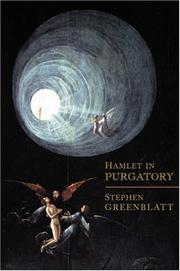
ISBN: 0691058733 Year: 2001 Publisher: University presses of California, Columbia and Princeton,
Abstract | Keywords | Export | Availability | Bookmark
 Loading...
Loading...Choose an application
- Reference Manager
- EndNote
- RefWorks (Direct export to RefWorks)
Christianity and literature --- English drama (Tragedy) --- Ghosts in literature. --- Purgatory in literature. --- Religion in literature. --- Tragedy. --- Voyages to the otherworld in literature. --- History --- Christian influences. --- SHAKESPEARE, WILLIAM (1564-1616) --- CHRISTIANISME ET LITTERATURE --- TRAGEDIE ANGLAISE --- VOYAGE DANS LA LITTERATURE --- FANTOMES DANS LA LITTERATURE --- PURGATOIRE DANS LA LITTERATURE --- HAMLET --- GRANDE-BRETAGNE --- INFLUENCE CHRETIENNE

ISBN: 0851159486 085115817X 1782045031 1846154928 1322591660 9781846154928 Year: 2001 Publisher: Woodbridge Boydell
Abstract | Keywords | Export | Availability | Bookmark
 Loading...
Loading...Choose an application
- Reference Manager
- EndNote
- RefWorks (Direct export to RefWorks)
Stories of spirits returning from the afterlife are as old as storytelling: accounts of ghosts and revenants which have crossed the mysterious border between the living and the dead are a dominant theme in many cultures, and in medieval Europe ghosts, nightstalkers, wild hunts and unearthly visitors from parallel worlds have figured in stories already in circulation before the coming of Christianity.
Medieval Ghost Stories is a collection of ghostly occurrences from the eighth to the fourteenth centuries; they have been found in monastic chronicles and preaching manuals, in sagas and heroic poetry, and in medieval romances. In a religious age, the tales bore a peculiar freight of spooks and spirituality which can still make hair stand on end; unfailingly, these stories give a fascinating and moving glimpse into the medieval mind. Look only at the accounts of Richard Rowntree's stillborn child, glimpsed by his father tangled in swaddling clothes on the road to Santiago, or the sly habits of water sprites resting as goblets and golden rings on the surface of the river, just out of reach...
Andrew Joynes's thoughtful commentary relates content and form to events of the time: the monastic reform movement following the first millennium, the growth in philosophical speculation during the twelfth century renaissance, and the channelling of ancient Norse beliefs by Christian authors into the saga literature of Iceland.
ANDREW JOYNES is a freelance writer, historian and broadcaster.
Phantoms --- Specters --- Spectres --- Apparitions --- Haunted places --- Civilization, Medieval --- Ghosts --- Medieval civilization --- Middle Ages --- Civilization --- Chivalry --- Renaissance --- History --- Esoteric sciences --- Christian special devotions --- anno 1200-1499 --- anno 800-1199 --- FANTOMES --- FANTOMES DANS LA LITTERATURE --- MOYEN AGE --- EUROPE --- Medieval ghost stories. --- miracles. --- spirituality. --- spooks. --- supernatural.
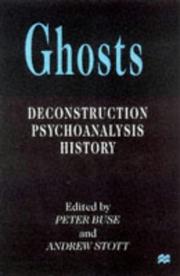
ISBN: 0333711440 Year: 2002 Publisher: Basingstoke Palgrave Macmillan
Abstract | Keywords | Export | Availability | Bookmark
 Loading...
Loading...Choose an application
- Reference Manager
- EndNote
- RefWorks (Direct export to RefWorks)
82.015.9 --- 82:159.9 --- 82:159.9 Literatuur en psychologie. Literatuur en psychoanalyse --- Literatuur en psychologie. Literatuur en psychoanalyse --- 82.015.9 Literaire stromingen: postmodernisme --- Literaire stromingen: postmodernisme --- Fantômes --- Fantômes dans la littérature --- Ghosts in literature --- Haunted houses --- Phantoms --- Revenants --- Specters --- Spectres --- Spoken in de literatuur --- Psychoanalyse --- cultuur en religie. --- Ghosts --- Psychoanalysis --- History
Book
ISBN: 2852036509 9782852036505 Year: 1997 Volume: 19 Publisher: Paris Champion
Abstract | Keywords | Export | Availability | Bookmark
 Loading...
Loading...Choose an application
- Reference Manager
- EndNote
- RefWorks (Direct export to RefWorks)
Folklore --- Comparative religion --- History of Europe --- anno 1200-1499 --- Fantômes dans la littérature --- Ghosts in literature --- Spoken in de literatuur --- Mythology --- Mythology, Germanic --- Mythologie germanique --- History --- Litterature medievale --- Chasse dans la litterature --- Themes, motifs --- Ghosts --- Europe --- Vergelijkende godsdienstwetenschap --- Volkskunde --- Geschiedenis van Europa --- Chasse sauvage. --- Littérature médiévale --- Chasse --- Légendes --- Mythologie --- Thèmes, motifs. --- Dans la littérature. --- Litterature medievale - Themes, motifs --- Littérature médiévale --- Légendes
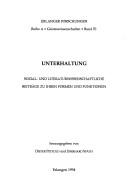
ISBN: 3922135897 9783922135890 Year: 1994 Volume: 70 Publisher: Erlangen Universitätsbibliothek
Abstract | Keywords | Export | Availability | Bookmark
 Loading...
Loading...Choose an application
- Reference Manager
- EndNote
- RefWorks (Direct export to RefWorks)
Leisure --- Recreation --- Popular culture --- Social psychology --- Philosophy --- Popular culture. --- Recreation. --- Social psychology. --- Philosophy. --- Mass psychology --- Psychology, Social --- Human ecology --- Psychology --- Social groups --- Sociology --- Manners and customs --- Amusements --- Community centers --- Culture, Popular --- Mass culture --- Pop culture --- Popular arts --- Communication --- Intellectual life --- Mass society --- Culture --- Leisure - Philosophy --- Spectacles et divertissements --- Vampires dans la litterature --- Fantomes dans la litterature --- Litterature d'epouvante --- Litterature fantastique --- Litterature enfantine --- Austen (jane), 1775-1817 --- Histoire et critique --- Discours, essais, conferences
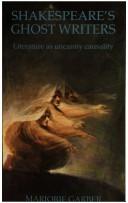
ISBN: 0416091229 0416094325 9780416091229 Year: 1987 Volume: 977 Publisher: New York : Methuen,
Abstract | Keywords | Export | Availability | Bookmark
 Loading...
Loading...Choose an application
- Reference Manager
- EndNote
- RefWorks (Direct export to RefWorks)
Ghosts in literature --- Psychoanalysis and literature --- Fantômes dans la littérature --- Psychanalyse et littérature --- Shakespeare, William, --- Authorship --- Characters --- Ghosts --- Criticism and interpretation --- Drama --- Psychological aspects --- Ghosts in literature. --- Psychoanalysis and literature. --- Psychological aspects. --- Fantômes dans la littérature --- Psychanalyse et littérature --- Authorship. --- Ghosts. --- Criticism and interpretation. --- Drama - Psychological aspects --- Shakespeare, William, - 1564-1616 - Criticism and interpretation --- Shakespeare, William, - 1564-1616 - Characters - Ghosts --- Shakespeare, William, - 1564-1616 - Authorship --- Shakespeare, William, - 1564-1616
Book
ISBN: 9782849520604 Year: 2008 Publisher: Paris Imago
Abstract | Keywords | Export | Availability | Bookmark
 Loading...
Loading...Choose an application
- Reference Manager
- EndNote
- RefWorks (Direct export to RefWorks)
Thematology --- Comparative literature --- Body and soul in literature. --- Death in literature. --- Dead in literature. --- Supernatural in literature. --- Ghosts in literature. --- Littérature comparée --- Esprit et corps dans la littérature --- Mort dans la littérature --- Morts dans la littérature --- Surnaturel dans la littérature --- Fantômes dans la littérature --- Themes, motives --- Thèmes, motifs --- Littérature comparée --- Esprit et corps dans la littérature --- Mort dans la littérature --- Morts dans la littérature --- Surnaturel dans la littérature --- Fantômes dans la littérature --- Thèmes, motifs --- Themes, motives.
Book
ISBN: 9789004278370 9004278370 9789004283626 9004283625 1322348812 Year: 2015 Volume: 376 Publisher: Leiden
Abstract | Keywords | Export | Availability | Bookmark
 Loading...
Loading...Choose an application
- Reference Manager
- EndNote
- RefWorks (Direct export to RefWorks)
In Figures de l’épouvante grecques de l’antiquité au présent , Maria Patera examines an unfamiliar aspect of the Greek pedagogy of fear, illustrated by narratives about four Greek terrifying figures: Lamia, Mormô, Gellô and Empousa. These female bogeys belong to the children's world. Each of those figures provokes fear in a particular way, according to its own characteristics (metamorphosis, hybridity, cannibalism, et cetera). By means of a diachronic comparison of the ancient figures with their Byzantine and modern Greek namesakes, each of them is assigned a proper position within its specific historical, cultural, and religious context. Dans Figures de l’épouvante grecques de l’antiquité au présent , Maria Patera examine un aspect mal connu de la pédagogie grecque, celui de la peur, illustré à travers des récits principalement destinés aux enfants à propos des épouvantails Lamia, Mormô, Gellô et Empousa. Ces quatre figures féminines appartiennent aux chambres enfantines et aux contes de bonnes femmes. Chacune d’entre elles matérialise un aspect de l’épouvante à travers ses façons d’agir et ses traits caractéristiques (métamorphose, hybridité, anthropophagie, et cetera). Un examen diachronique permet de comparer les personnages anciens à leurs homonymes byzantins et néo-grecs et de déterminer leurs fonctions respectives dans chaque contexte historique, religieux et culturel donné.
Greek literature --- Byzantine literature --- Fear in literature. --- Children in literature. --- Ghosts in literature. --- Monsters in literature. --- Mythology, Greek --- Littérature grecque --- Littérature byzantine --- Peur dans la littérature --- Enfants dans la littérature --- Fantômes dans la littérature --- Monstres dans la littérature --- Mythologie grecque --- History and criticism. --- Psychological aspects --- Histoire et critique --- Aspect psychologique --- Fear in literature --- Children in literature --- Goddesses, Greek, in literature --- Ghosts in literature --- Monsters in literature --- History and criticism --- Littérature grecque --- Littérature byzantine --- Peur dans la littérature --- Enfants dans la littérature --- Fantômes dans la littérature --- Monstres dans la littérature --- Goddesses, Greek, in literature. --- Childhood in literature --- Children in poetry --- Greek literature - History and criticism --- Byzantine literature - History and criticism --- Mythology, Greek - Psychological aspects
| Listing 1 - 10 of 11 | << page >> |
Sort by
|

 Search
Search Feedback
Feedback About UniCat
About UniCat  Help
Help News
News